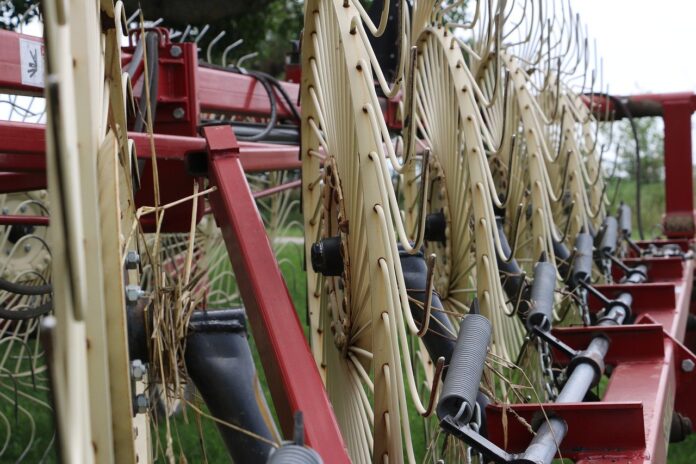All of the equipment we utilize for making hay has one goal: to dry hay to the optimum moisture for storage then package densely for storage.
It is amazing how little adjustments in the shop can save a couple of much-needed hours of drying time. Your operator’s manual will have the proper adjustments for your machine.
Going through each piece of equipment now will make sure that it will function to the highest level of efficiency.
Improved hay drying starts with the mower conditioner at the cutter bar. The primary winter service to prevent this is to make sure knives are sharp and not dragging on the cutter bar when spinning for disc mowers.
For sickle mowers, inspect knife sections and closely inspect guards to be sure knife sections and guards are not worn and still cut with a scissors action. This is also a good time to check all gearboxes and, on disc mower conditioners, that cutting modules are not worn to the point of becoming out of time.
Conditioning system
This is also the time to check the conditioning system for proper adjustment. The area between each cutting module, where more crop runs, can have more wear than the center of each module, to the point that you could not adjust roll clearance properly.
So how do you determine if your rolls need adjustment? First, you will need three pieces of aluminum foil, each 18 inches long. Next, find a 3/8″ rod at least 18 inches long and roll the aluminum foil around it, creating 3/8″ diameter by 18-inch long roll clearance gauge checkers.
Make sure the mower is lowered to the ground or locked up. Insert the homemade roll gauges into the rolls and turn them over by hand until they fall out the back. Roll gauges should be put in the middle and about a foot from each end, or if you can feel wear, put the gauges in both the high and low spots.
Once the roll gauges are through the machine, measure the crush points with a digital or dial caliper. The roll clearance for standard rolls should be 1/16 inch to a maximum of 3/32 inch. Measure all crush points on the aluminum foil roll and find the average. Watch for measurements that are out of range over the length of the 18-inch long roller gauge.
Tedder maintenance
Proper tedder maintenance is important so that hay is spread evenly over the field, and all hay pressed against the ground is fluffed to allow for better air movement.
When it comes to winter tedder maintenance for drying, the best method is to unfold the tedder on level concrete and check it for levelness across the width of the machine. Many of us do not have level concrete; another good option is to use a level plywood frame.
When the machine is in the run position, all tines should be the same distance from the ground, ¾-inch works well for adjustments.
The four most common reasons tedders are not level are bent arms, bent wheel carrier arms, improper tire pressure and replaced tines that are longer than the rest. When replacing tines, they need to be cut to match the length of all the worn tines on your machine.
On some of these machines, this may mean that the tines will need cut at different lengths. Some machines wear to have a shorter back tine in the pair compared to the front tine.
Inspect pivots for wear. Allowing wings to tip more than the mainframe, can cause them to miss hay behind the tractor and add soil to the forage on the wings.
Rake
The last line of defense in our hay drying system is the rake. The rake’s ability to assist in the drying process is greatly affected by type, adjustments and maintenance.
On the maintenance side, just like for tedders, it is important to make sure these machines are level, tines are similar length (cutting if needed), spring suspension is not broken, and adjustments are correct.
If you ever replace all tines on the rake, keep a good selection of the used tines as replacements for the future.
With a parallel bar rake, the basket angle can be adjusted. When this adjustment is in the up position, windrows are fluffier, improving drying, but over time, this slot adjustment falls to the bottom or down position, making windrows tighter and slowing drying speed.
If running a different tractor on your rakes, check hitch height to be sure rakes run level.













